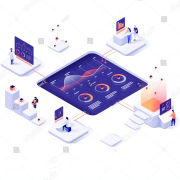Adapting to the demands of the market and the customers means inevitable changes for the banks. According to Fujitsu, 37% of European consumers would change their bank if it did not offer cutting-edge technology. Data-driven means better customer service, more optimization and security. How do the banks take advantage of data?
The banking sector is increasingly adopting Big Data and Cloud into their business models. Deloitte reports that just 25% of European banks feel confident and are ready to implement the changes. Banks are teaming up with small FinTech companies and start-ups or big players as Microsoft to develop better tech abilities and deliver their products in the best possible way.
Netflix-like Bank
As with any other service these days, customers expect tailored services from their banks. Accenture’s 2019 Global Financial Services Consumer Study states that one in two customers would like to get reports on spending habits as well as advice on money management. Trying to meet these needs and expectations, over 40% of finance-related companies consider adding personalized services to their offer, according to Econsultancy.
Unfortunately, as revealed by TheFinancialBrand, 94% of the banks do not deliver proper personalization for their clients. However, there are still a few examples of good practices.
For example, Bank of Ireland started to use customer data in a way that is similar to organisations like Netflix. Using online and offline data, the bank advises customers with the right action at the very moment they need it.
The personalized content in customer communication has increased the number of loan application submissions by 15%
Another bank following the Netflix path is Aion, the new arrival on the Belgian market, launched by Wojciech Sobieraj. Based on a subscription model, Aion gives access to the services by monthly subscription. Customers can purchase one of two different options; basic services or advanced plan, including the tool MoneyMax, which helps to improve money management.
Italian automation
As reported by McKinsey, automation can cover even 30% of the workload in banks. Apart from minimizing costs and increasing productivity, automated workflows allow banks to re-organize their personnel and systems.
A great example of workflow automation implementation is Italian bank Banca Popolare di Sondrio. Moved by a need to quickly launch new customer services and keep control costs under, Banca Popolare di Sondrio invested in automation. Thanks to that, the organization managed to decrease the average transaction handle time from 1 hour to 10 minutes. With flawless processes in place, the quality of customer service took off, followed by time and cost savings. Within the three coming years, Banca Popolare di Sondrio expects cutting costs in 40% of development and testing phases through intensified productivity and increased efficiency.
When partnership means security
Apart from money, banks handle a massive amount of data, which makes them, even more, a target of potential attacks. To protect both the clients as well as the organizations, investment in cybersecurity is crucial. Fortunly forecasts global spending in this area to surpass $6 trillion by 2021. CitiBank has already invested a lot in Big Data technologies and startups. Their partnership initiative with tech companies, Citi Ventures, is a good example of how a bank can focus on cybersecurity. The recent investment, a data science company Feedzai, helped CitiBank to minimize financial risk for online banking providers. Thanks to the real-time machine learning and predictive modelling solutions, CitiBank can now track possible frauds, unusual charges or any suspicious transactions. Their clients are notified about the detected anomalies on their accounts. At the same time, Feedzai helps providers and retailers to monitor all financial activity and identify threats related to their business.
The wind of change
Focus on customer experience, automation and higher investments in cybersecurity will inevitably impact the banks’ offer. With many new fin-techs emerging lately as an alternative to traditional banking, banks need to reestablish their operations, processes and adopt new approaches if they want to stay competitive on the market.
Changes should take place quickly, and the industry is starting to realize the fact. At the latest Digital Finance Summit conference (a more detailed report coming soon) Pierre-Alexandre Boulay, Head of Sales CEE from Backbase postulated moving away from the long-term RFP (Request for Proposal) procedure. Instead of a long-lasting process, sometimes taking up to 2 years, he proposed a more agile approach: using a Proof of Concept and a quick decision-making framework to start projects within 6 months. Will this be a game changer in a way to compete with aggressive fintech strategies? In my view it could be one to put the bets on.
Still, the potential of data-driven banking has not yet been fully discovered and exploited. Only a small number of banks have been successful in data-leveraging as 85 % initiatives normally fail in this area. Learn how CCA Europe’s solution could help you use some of your data to your benefit. Contact us for a discovery call.

